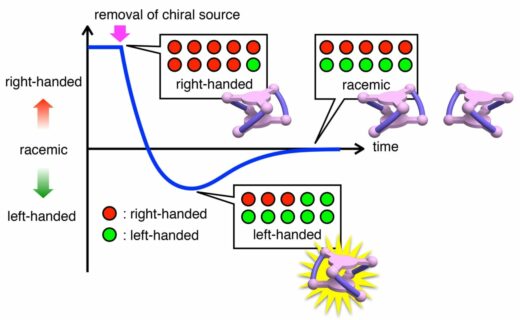Changing the handedness of molecules
Researchers at Kanazawa University report in Proceedings of the National Academy of Sciences a responsive molecular system that, through chemical reactions, inverses its chirality before becoming racemic.
Molecules that have the ability to change their structure in response to a chemical or physical stimulus are called ‘responsive molecules’. This type of molecule plays an important role in signal transduction at the nanoscale. The typical time profile of a structural change of a responsive molecule follows an exponential relaxation. However, molecular systems with non-typical time responses, such as e.g. chemical oscillators (whose structure switches periodically between two states), offer advanced functionalities and are also intensively investigated. Shigehisa Akine and colleagues from Kanazawa University have now designed a particular responsive molecule in which the chirality (‘handedness’) changes in a non-exponential fashion. The achievement is a breakthrough in the field of responsive systems as the chirality change happens in a unimolecular system — not, as has often been the case before, in supramolecular assemblies.
The researchers’ responsive molecule has six exchangeable sites; it can be written as [LCo3X6]3+, where X stands for a ligand at each of the six sites. The molecule has two forms, a ‘left-handed’ (abbreviated ‘M’) and a ‘right-handed’ (abbreviated ‘P’) version. In solution, the two forms will occur, in a given ratio. Akine and colleagues started from the molecule where X is a particular chiral amine labeled A (chiral means that the ligand and its mirror image cannot be superimposed, and amine refers to a type of molecular group containing nitrogen). In a methanol solution, the P/M ratio of [LCo3A6]3+ was 88:12, meaning that the right-handed version was dominant. The scientists then looked at what happened when exchanging the chiral A groups with piperidine (another, but achiral, amine).
Because of the achirality of the piperidine groups, the resulting [LCo3(piperidine)6]3+ solution should become ‘racemic’, which means that any effects of chirality are compensated. This is indeed what happened, but the researchers discovered that before reaching the racemic state after two days, the solution first switched from originally P-dominant to M-dominant after 7 minutes, with maximum M-dominance after 60 – 120 minutes. Remarkably, a similar transient chirality inversion was not observed for the reverse reaction, [LCo3(piperidine)6]3+ to [LCo3A6]3+, for which the solution changed monotonically from racemic to P-dominant.
Akine and colleagues note that their [LCo3X6]3+ responsive molecule is the first unimolecular platform displaying a transient chirality inversion, and that the unique chirality change happens on the timescale of minutes to hours, which could be potentially useful for time-dependent functional materials related to human activity. Quoting the scientists: “this result will provide an important insight into the science of autonomously driven materials.”
Background
Enantiomers
An enantiomer (sometimes called optical isomer) is one of two molecules that are mirror images of each other but are not superimposable, just like one’s left and right hands. The two members of a pair of enantiomers are also called enantiomorphs.
In symmetric environments, enantiomers have identical physical properties except for one: the ability to rotate a particular form of polarized light (so-called plane-polarized light) by equal amounts but in opposite directions. Enantiomers are therefore referred to as optically active. A mixture consisting of an equal number of both enantiomorphs of an enantiomer pair is called a racemic mixture; a racemic mixture is never optically active.
Shigehisa Akine and colleagues from Kanazawa University have now discovered a molecular system in solution that, through chemical reactions, changes its overall ‘handedness’ (chirality) from right to left, before becoming racemic.
Related Image
Figure 1. The transient chirality inversion in this study.
A right-handed helical cobalt(III) complex underwent the chirality inversion to give the left-handed form before complete racemization upon removal of the chiral source.
Researcher’s information
Article
- Title
- Transient Chirality Inversion during Racemization of a Helical Cobalt (III) Complex. Proceedings of the National Academy of Sciences of the United States of America, 119 (11)
- Author
- Yoko Sakata, Shunsuke Chiba, and Shigehisa Akine
- Journal
- Proceedings of the National Academy of Sciences of the United States of America
- Publication date
- Mar 8, 2022
- DOI
- 10.1073/pnas.2113237119
- URL
- https://www.pnas.org/doi/10.1073/pnas.2113237119


